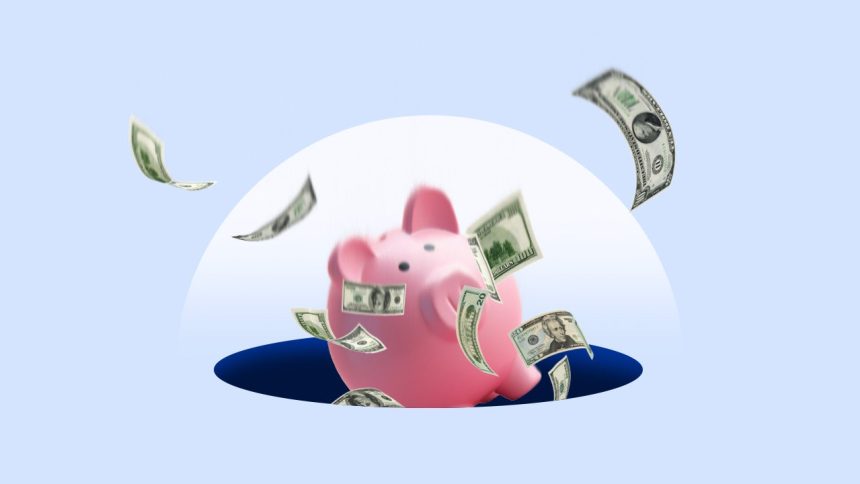Key takeaways
- Traditional banks like Chase, Bank of America and Wells Fargo typically offer just 0.01 percent APY on savings accounts, while online banks offer 4.4 percent or higher.
- A $10,000 deposit would earn just $2 in interest over two years at 0.01 percent APY, compared to $899 at 4.4 percent APY.
- You can keep your existing checking account while moving your savings to a high-yield account at another bank. Most high-yield savings accounts have no minimum deposit requirements or monthly fees.
- Despite the benefits, 45 percent of Americans cite branch access as their reason for not using online banks.
Your bank could be making a fortune off your savings while offering almost nothing in return.
A $10,000 deposit at Chase, Bank of America, or Wells Fargo typically earns just $2 in interest over two years. That same money at a competitive online bank would have generated at least around $751.69 more during the past two years.
This “loyalty tax” is costing savers trillions collectively at a time when inflation is threatening savers’ purchasing power.
Competitive high-yield savings accounts still offer around 4 percent annual percentage yield (APY) or higher, which is over 400 times the standard 0.01 percent APY offered by many major banks. This yield difference represents an opportunity for savers to not just preserve their purchasing power but to outpace inflation.
Here’s how much money is being left on the table and how to make the switch.
The high cost of low-yield accounts
Big banks like Chase, Bank of America and Wells Fargo generally offer 0.01 percent APYs as the standard yield on savings deposit accounts at their banks.
This meager return fails to keep pace with inflation, effectively eroding your purchasing power over time.
The difference in earnings is stark. Consider this comparison with $10,000 saved over two years:
| Account Type | APY | Interest earned (2 years) | Final balance |
|---|---|---|---|
| Traditional bank | 0.01% | $2.00 | $10,002.00 |
| High-yield savings | 4.40% | $899.36 | $10,899.36 |
This $897 difference represents real money that could help with expenses, bolster emergency funds or contribute to financial goals. The lost opportunity grows even more significant with larger balances or longer timeframes.
Find the best savings account: Compare Bankrate’s top-rated high-yield savings accounts.
Some traditional banks do offer premium savings options with higher yields, but they often come with substantial restrictions. For instance, Wells Fargo has a relationship yield of 2.51 percent APY but only for balances of on $1 million or more.
In contrast, most online-only banks offer competitive rates with no minimum deposit requirements and no monthly service fees.
Why people stay with low-yield accounts
Inertia is one reason that people stay in an account that isn’t earning high interest. It’s the “if it ain’t broke, don’t fix it” mentality. And that thinking does make sense in some instances in life.
But when doing the same thing – and not changing your habits costs you money, that that becomes a problem.
A Bankrate survey from March 2024 revealed the top reasons people cited for not moving their savings to online banks:
Preferred access to a local branch
Nearly half of respondents (45 percent) cited preference for local branch access as their primary reason for avoiding online banks. However, you don’t don’t need to abandon your local bank relationship to benefit from high-yield savings.
This misconception costs the average saver hundreds or even thousands of dollars over time. Before declining a potential $900 in extra interest, consider how often you actually visit your branch for savings-related transactions.
Comfort level with current financial institution
Familiarity and routine keep many customers loyal to their existing banks. The average person maintains a relationship with their brick-and-mortar bank for 18 years, according to Bankrate’s latest Checking Account Survey.
This comfort comes at a significant cost. If you had $10,000 just sitting in a checking account at your current bank, would you rather have nearly $900 or $2 after two years?
For those hesitant to make a complete switch, consider starting small. Many high-yield savings accounts allow you to open an account for as little as $1.
Security concerns
Many consumers express worries about the safety of their money at online banks they’re less familiar with.
“There are over 4,000 banks in the country so just because you’re not familiar with a bank’s name is not a reason to shy away,” says Greg McBride, CFA, Bankrate chief financial analyst. “As long as you are dealing directly with an FDIC-insured financial institution, (your) money is protected just the same as it is at the bank down the street.”
The FDIC provides standard insurance of up to $250,000 per depositor, per bank, for each account ownership category. This protection applies equally to traditional and online banks with FDIC insurance.
Not enough savings to make it worthwhile
Some savers believe their balance is too small to benefit from higher rates. This misconception undervalues even modest interest earnings.
Consider this: if you save $100 at 3.7 percent APY for a year, you’ll earn $3.70 in interest.
While that might seem small, it’s the equivalent of getting a free pound of apples at the grocery store. Most people wouldn’t pass up a $1 discount on produce, yet they overlook the opportunity to earn several times that amount through better interest rates.
The power of compound interest over time
Compound interest — earning interest on your interest — creates dramatic differences between low and high-yield accounts over time. The longer your money remains invested, the more pronounced this effect becomes.
Consider these comparisons:
| Initial deposit | APY | 3 Years | 5 Years | 20 Years |
|---|---|---|---|---|
| $10,000 | 0.01% | $3.00 | $5.00 | $20.02 |
| $10,000 | 3.7% | $1,151.58 | $1,992.06 | $10,681.17 |
| $50,000 | 0.01% | $15.00 | $25.01 | $100.10 |
| $50,000 | 3.7% | $5,757.88* | $9,960.30 | $53,405.86 |
After 20 years, $10,000 in a high-yield account would earn over $10,600 in interest—more than 530 times the $20 earned in a traditional account. This difference represents significant lost opportunity for long-term savers.
Calculate your earnings: Use Bankrate’s savings calculator to see how much you could earn.
Online banks gaining market share
The benefits of online banking haven’t gone unnoticed. Data from the Federal Financial Institutions Examination Council shows how online-only banks such as Ally Bank and Discover Bank are growing at much faster rates than traditional banking giants.
| Savings/MMDA deposits (12/31/2019) | Savings/MMDA deposits (12/31/2024) | Percent change | |
| Chase | $905,527,000,000 | $1,290,675,000,000 | 42.53% |
| Bank of America | $1,045,856,000,000 | $1,314,347,000,000 | 25.67% |
| Wells Fargo | $1,073,022,000,000 | $369,176,000,000 | -65.59% |
| Ally Bank | $59,788,000,000 | $98,987,000,000 | 65.56% |
| Discover Bank | $38,994,384,000 | $66,095,994,000 | 69.50% |
While traditional banks still control the majority of deposits, online banks are growing at more than double the rate of their traditional counterparts, reflecting increasing consumer awareness of high-yield options.
How to maintain your banking relationship while maximizing yields
The good news is that switching to a high-yield savings account doesn’t require abandoning your current bank relationship.
“You don’t need to change anything about your current day-to-day financial routine in order to get better returns in an online savings account,” McBride says. “You’re just sending your savings somewhere it will be welcomed with open arms and higher returns. You can then conveniently link this online savings account with the checking account at your current financial institution to easily move money back and forth as needed. You still retain the same accounts with your current bank and have access to their branches if you need it, but your savings will be working for you rather than the bank.”
This hybrid approach — keeping your checking account at your current bank while moving savings to a high-yield account — offers the best of both worlds. You maintain familiar banking relationships and branch access for daily transactions while earning competitive returns on your savings.
Separating your savings from the bank where your checking account is can help you not spend this money on unintended expenses.
Steps to switch to a high-yield savings account
Generally, the way to earn more on your savings is to have a high-yield savings account at an FDIC-insured online bank. Here’s how to make the switch:
- You want to carefully research a bank before switching, since generally they are long-term relationships. Compare rates, fees and features at Bankrate’s best high-yield savings accounts to find the right fit for your needs.
- Make sure you understand the minimum opening deposit requirement, the minimum balance you’ll need to keep in the account to avoid fees and what the monthly service fee would be before opening your account. Most online banks don’t have these, but it’s always wise to verify.
- Make a small test transfer to ensure everything works properly. You’ll also want to make sure to link your existing checking account to your new high-yield savings account for easier transfers.
- Check the features on your new account. If mobile deposit or ATM access is important to you, make sure your high-yield savings account has these features.
Bottom line
With high-yield savings accounts currently offering rates that outpace inflation, there’s never been a better time to optimize your savings strategy.
But you have to actually have to have your money in one of these accounts to be taking advantage of this.
Read the full article here
















